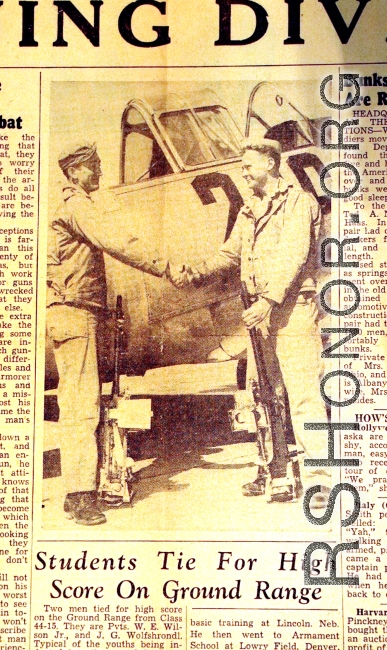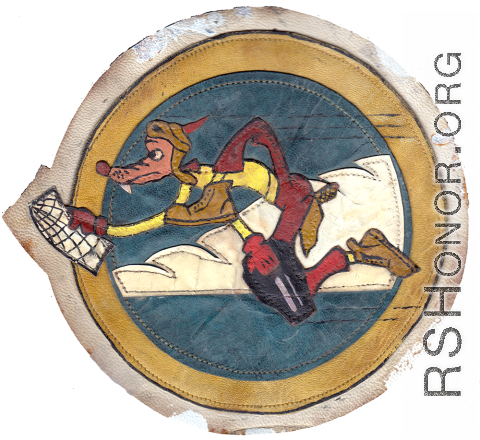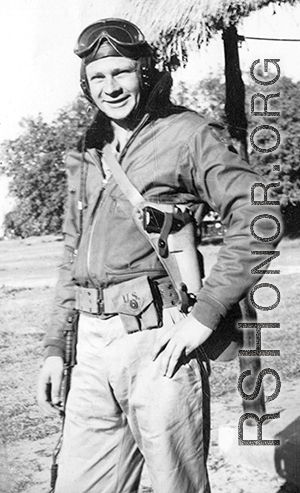Sgt. John G. Wolfshorndl, 24th Combat Mapping Squadron, at Gushkara, India, with Colt pistol (serial No. 1797200). He flew as nose gunner on a F-7, a photographic reconnaissance version of the B-24 bomber.
John Gustave Wolfshorndl was born on February 16, 1925 in Madera, California. He lived with his parents and sister on their ranch and dairy in Chowchilla, California, in the Dairyland District. John attended Bethel Elementary School and graduated in 1943 from Chowchilla High School. John was 17 years old when the war started, and remembers just returning home from church when someone drove up and said Pearl Harbor had been bombed, upon which one of his first thoughts was, "What and where is Pearl Harbor?" But the next day in school a formal announcement was made, and it struck him suddenly that many of the seniors would soon be going off to war.

John enlisted in the United States Army Air Forces in June 1943, destined to be a turret gunner on a B-24 Liberator in the skies over Europe. Military training included Basic Training in Kearns, Utah; Aerial Gunnery, Laredo, Texas; Armorer, Lowery Field, Denver, Colorado; Combat Crew Training, Peterson Field, Colorado and Mountain Home, Idaho. His long-anticipated first airplane ride was in an AT-6 trainer, but him flying backward as he was behind the pilot, turned facing the air behind the aircraft, hands on a .30 cal machine gun, ready to practice aerial gunnery.
As training was winding down, the destiny of the crew took a big turn. Originally, Wolfshorndl and the crew were soon to head for B-24 missions in Europe, but one evening, tail gunner John T. Swick, left base to go to a bar to drink. As curfew approached, Swick talked the bartender into loaning him civvy clothing so he could stay out later, without MPs being able to easily identify him as a rogue GI. But as Swick drank he got rowdy, and after enough irritation at his escapades, naturally someone called the MPs. The MPs locked Swick up in the brig, awaiting court martial.
In the meantime, upon hearing the news, the pilot Mike Howes decided that something needed to be done and done quick: The crew had trained together for over a year, and a court martial would mean disrupting the crew, and the assignment of an unknown new tail gunner. So pilot Howes contacted operations and asked if there were any outfits elsewhere that needed flight crews. Sure enough, photographic units at Will Rogers Field flying F-7s needed flyers. Swick was released on his own recognizance (ROR), and the crew—the delinquent drinker Swick included—grabbed a flight together to Will Rogers, and thus by leaving the authority of the MPs behind, the original crew was left intact. Six weeks of training in aerial photography and mapping followed.
Then the crew flew to Miami Beach, and on October 29, 1944, they boarded a C-54 transport heading out over the Atlantic, only later to find they were headed, via multiple stops, toward Karachi, India, arriving November 2, 1944. Once in Karachi, they changed planes to Gushara, India, which became their home base for operations. Later they were in Chanyi (Zhanyi), China, for one month--where they quickly experienced a Japanese bombing raid and the frantic scramble to find a slit trench to throw themselves into. They flew with the 24th Combat Mapping Squadron (24th CMS), mapping strategic areas from 20,000 feet above the terrain, using large Fairchild cameras that shot film 9 inches wide, on rolls 500 feet long. Usually they flew alone rather than in group missions, a solitary (sometimes lonely and frightened) aircraft over areas often hostile, with extra range via extra fuel in a converted bomb bay.

Cpl. and later Sgt. Wolfshorndl mostly flew as nose-gunner in the CBI, only on tail gun once—he felt too claustrophobic in the narrow elongated turret space in the tail. And during his one real mission in the tail turret, shrapnel cutting through the aircraft from Japanese anti-aircraft fire only reinforced his dislike for the confined tail space (although after crawling out between the tight formers and bulkheads of the tail, he did collect an excellent keepsake—a piece of bent shrapnel—from the floor of the aircraft near a ragged hole that he noticed in the fuselage). So he made sure to swing things so as to stay in the nose position. Hot and humid on the ground in India, the nose turret was freezing cold when flying at altitude.
USO shows were a big event for the men stationed abroad, and well appreciated.
By the end, he had flown eighteen combat missions in the F-7 as a nose gunner (over 400 hours in the nose turret), mapping the terrain of the CBI, flying mostly in an F-7 nicknamed "The FLYING ANVIL," that is to say, if more than two of the four engines stopped, the craft would drop like and anvil. Shortly after the Japanese surrender, he was asked if he would like extend his service for a while in the Philippines. Upon this apparent first instance of being asked for his personal opinion during his time in the military, his response was resoundingly that he wanted to go home.
All told, he served 2 ½ years, and left the CBI for return to the US on September 27, 1945, arriving in the US on October 25, 1945.
Returning home to Chowchilla, California, John Wolfshorndl soon married Glenda Wisener in 1951, and they would start a large family together.
John was a founding member of Trinity Lutheran Church in Chowchilla. He was a member of Chowchilla Red Top Soil Conservation District for 70 years, Dairyland School Board member, Minturn Almond Huller Director, American Legion and VFW member, Boys State/Girls State organizer, and a member of the Chowchilla Rural Fire Department. And, of course, he freely shared his stories of his time in the CBI to those who were interested.
John loved life, and he was known for his generosity, devotion and love for God, family, church, friends and neighbors. He loved to farm. He had a great sense of wit that made people smile. Fishing, hunting, playing pinochle, and attending family events were a part of his daily life and friendships.
John Wolfshorndl passed away on December 4, 2018 surrounded by his family in Merced, California.
He was the last survivor of his original crew.
(Compiled by Patrick Lucas from interview notes and video, enlistment records, public obituary, online interview, and other sources.)
